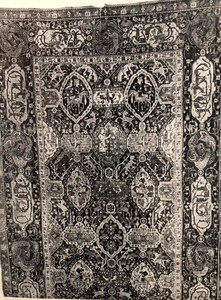At Boughton you can also see one of Britain’s most outstanding collections of fine art, furniture, tapestries, porcelain and carpets including "the rug dealer favorite carpet ":The Buccleuch Sanguszko Carpet with Offset Medallions and Cartouches, 226 x 452 cm, wool pile on a cotton and wool foundation which belongs to the Duke of Buccleuch and Queensberry, Boughton House, inv. no. 97-502, Richard Walter John Montagu Douglas Scott, 10th Duke of Buccleuch and 12th Duke of Queensberry, KT KBE FSA FRSE (born 14 February 1954), styled as Lord Eskdaill until 1973 and as Earl of Dalkeith from 1973 until 2007, is a Scottish landholder and peer. He is the Duke of Buccleuch and Queensberry, as well as Chief of Clan Scott. He is the senior patrilineal descendant of James, Duke of Monmouth (9 April 1649 – 15 July 1685), the eldest illegitimate son of King Charles II and his mistress, Lucy Walter. Through Charles, he is a direct descendant of Mary, Queen of Scots. In 2013,
The Herald reported that the Duke was Scotland's largest private landowner, with some 280,000 acres (110,000 ha).The Buccleuch carpet is classified as the Sanguszko carpets, of which more than a dozen examples are known, are distinguished by figurative decoration closely tied to manuscript illustration, a bright appearance owing to abundant use of white in the pile, and certain technical peculiarities. The group owes its name to the former owner of one magnificent example of the group (currently on loan to The Metropolitan Museum of Art, no. L1985.3; Survey of Persian Art, pl. 1206). Medallion designs with symmetrically arranged floral patterns predominate, but directional designs with figurative motifs are also found. Animal-combat motifs are plentiful, and animal heads often inhabit palmettos and border designs. Clusters of human figures embellish discrete compartments in the field or border; some of these figures can be directly linked to manuscript illustrations, for example, scenes from Laylī o Majnūn and images of fighting camels, a popular subject first seen in an early 10th/16th-century painting by Behzād. Technically the Sanguszko pieces resemble the so-called vase carpets with cotton warps and wefts of wool and silk, but they differ in other ways. The localization of this group is highly conjectural; Kāšān, Yazd, Kermān, and Qazvīn have all been suggested, but certain differences within the group suggest that these carpets were produced at more than one weaving center. A date late in the 16th, or perhaps even early in the 17th, century seems plausible on the basis of the figure style and the existence of Indian copies that probably date from the early 17th century.



